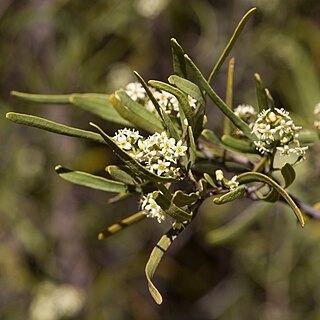The elm cultivar Ulmus 'Rubra' was reputedly cloned from a tree found by Vilmorin in a wood near Verrières-le-Buisson in the 1830s. It was listed in the 1869 Catalogue of Simon-Louis, Metz, France, as Ulmus campestris rubra, and by Planchon in de Candolle's Prodromus Systematis Naturalis Regni Vegetabilis (1873) as Ulmus libero-rubra: 'Orme à liber rouge' [:elm with red inner bark]. Elwes and Henry (1913) and Bean (1936) listed it as Ulmus montana [:U. glabraHuds.] var. libro-rubro, the former stating that the tree appeared "identical" to Simon-Louis's Ulmus campestris rubra. A specimen in the Zuiderpark, The Hague, was identified in 1940 as a wych elm cultivar, U. glabraHuds.libero rubro.
Hoplophyllum is a genus of flowering plants in the family Asteraceae. It has two species, Hoplophyllum spinosum and Hoplophyllum ferox, both native to South Africa.
Platycarpha is a genus of South African plants dandelion subfamily within the daisy family.

Coronidium elatum, commonly known as the white paper daisy or tall everlasting, is a perennial herbaceous shrub in the family Asteraceae found in open forests in eastern Australia. A woody shrub 0.6 to 2 m tall, it has white flowers which appear in spring. It was known as Helichrysum elatum for many years until it was finally reviewed in 2008.

Eucalyptus ligustrina, commonly known as the privet-leaved stringybark, is a species of shrub, mallee or small tree that is endemic to New South Wales. It has rough, stringy bark, lance-shaped to egg-shaped adult leaves, flower buds in groups of between seven and fifteen, white flowers and hemispherical or shortened spherical fruit.

Drosera petiolaris is a carnivorous plant in the genus Drosera and is the eponymous species of the petiolaris species complex, which mostly refers to the entire subgenus Lasiocephala. It is native to Northern Australia, including the northern regions of Western Australia, the Northern Territory, and Queensland, and New Guinea; this distribution is the largest in the subgenus and the only that extends beyond Australia. Its leaves are arranged in a compact basal rosette with long, narrow petioles emerging from the center of the rosette. Carnivorous leaves are held at the end of the petiole with long retentive glands.

Bossiaea rhombifolia, is a species of flowering plant in the family Fabaceae and is endemic to eastern Australia. It is an erect, glabrous shrub with diamond-shaped, more or less round or broadly egg-shaped leaves, and yellow and red or pinkish flowers.
Amoreuxia palmatifida is a perennial herb with a native range from Arizona and New Mexico, through Mexico, Central America and Colombia. It has yellow flowers and long, narrow capsules. The leaves, roots, flowers, and fruits provided food for natives of Arizona and northern Mexico.
Chromolaena macrodon is a rare Caribbean species of flowering shrub in the family Asteraceae. It is found only the Island of Dominica in the Lesser Antilles.

Tremandra is a genus of flowering plants in the family Elaeocarpaceae. It contains two species, both endemic to Western Australia.
Tremandra diffusa is a species of flowering plant in the family Elaeocarpaceae. It is a small shrub with white flowers and green oval shaped leaves.

Leptospermum myrtifolium, commonly known as the myrtle tea-tree or grey tea-tree, is a species of shrub that is endemic to south eastern Australia. It has broad egg-shaped to elliptical leaves, white flowers usually borne singly on short side shoots, and fruit that remains on the plant until it dies.

Geijera linearifolia, commonly known as oilbush or sheepbush, is a species of shrub in the family Rutaceae and is endemic to southern Australia. It has simple linear to oblong leaves, much-branched cymes of greenish-white flowers, and fruit containing a shiny black seed.
Olearia chrysophylla is a species of flowering plant in the family Asteraceae and is endemic to eastern Australia. It is a shrub with scattered elliptic leaves, and white and yellow, daisy-like inflorescences.

Olearia cydoniifolia is a species of flowering plant in the family Asteraceae and is endemic to eastern Australia. It is a shrub with scattered elliptic leaves, and white and yellow, daisy-like inflorescences.
Olearia elaeophila is a species of flowering plant in the family Asteraceae and is endemic to the south-west of Western Australia. It is a small shrub with scattered linear leaves, and white or blue and yellow, daisy-like inflorescences.

Olearia quercifolia, commonly known as oak-leaved olearia, is a species of flowering plant in the family Asteraceae, and is endemic to the Blue Mountains in New South Wales. It is a shrub with elliptic to egg-shaped leaves with the narrower end towards the base, and white and yellow daisy flowers.

Leucopogon melaleucoides is a species of flowering plant in the heath family Ericaceae and is endemic to eastern Australia. It is an erect, densely branched shrub with lance-shaped or egg-shaped leaves, and white, tube-shaped flowers arranged in spikes in upper leaf axils.
Peperomia variifolia is a species of plant from the genus 'Peperomia'.
Pimelea milliganii, commonly known as silver riceflower or Milligan's rice flower, is a species of flowering plant in the family Thymelaeaceae and is endemic to a restricted part of Tasmania. It is a low, much-branched, densely hairy shrub with more or less elliptic leaves and compact clusters of white to pinkish flowers usually surrounded by two leaf-like involucral bracts.










